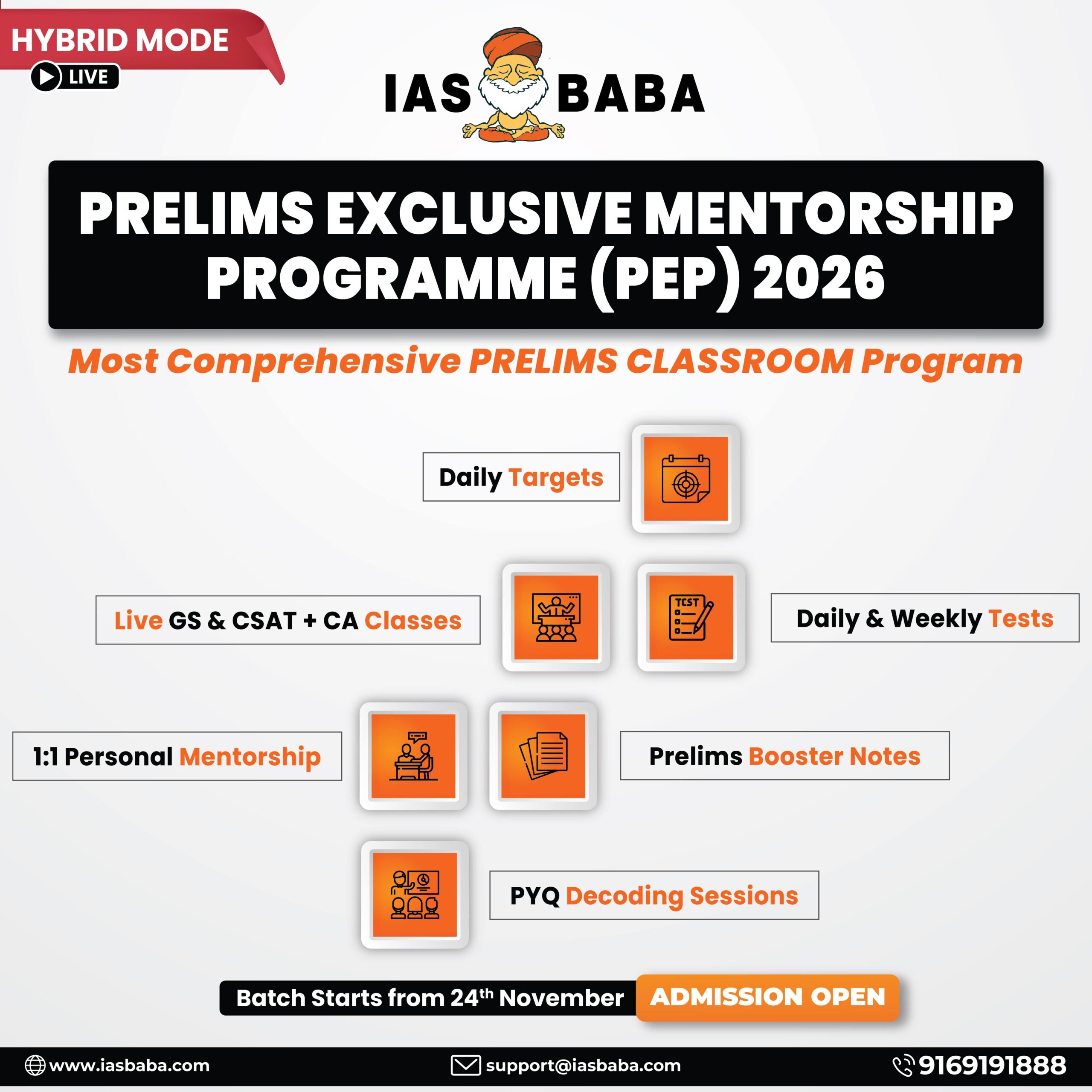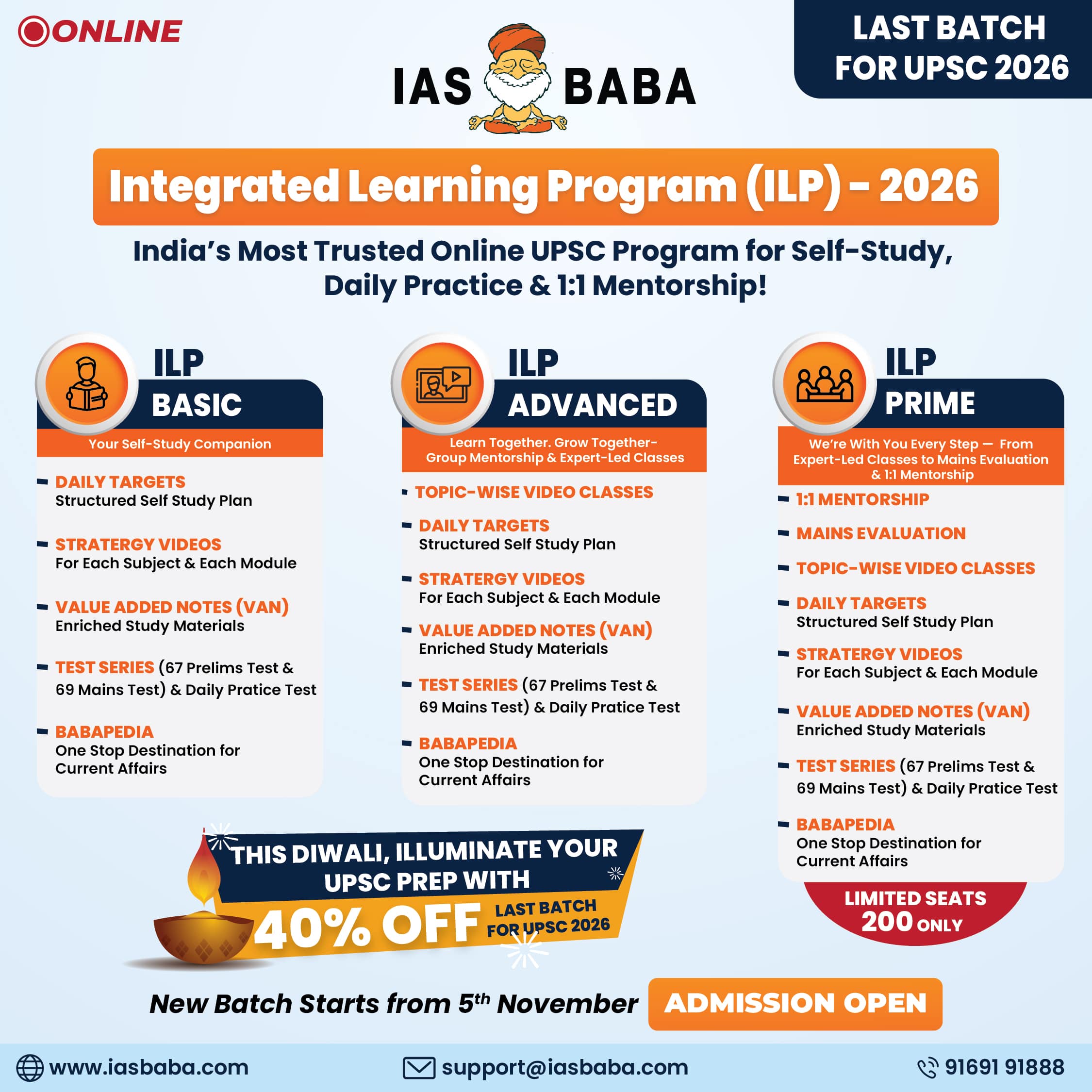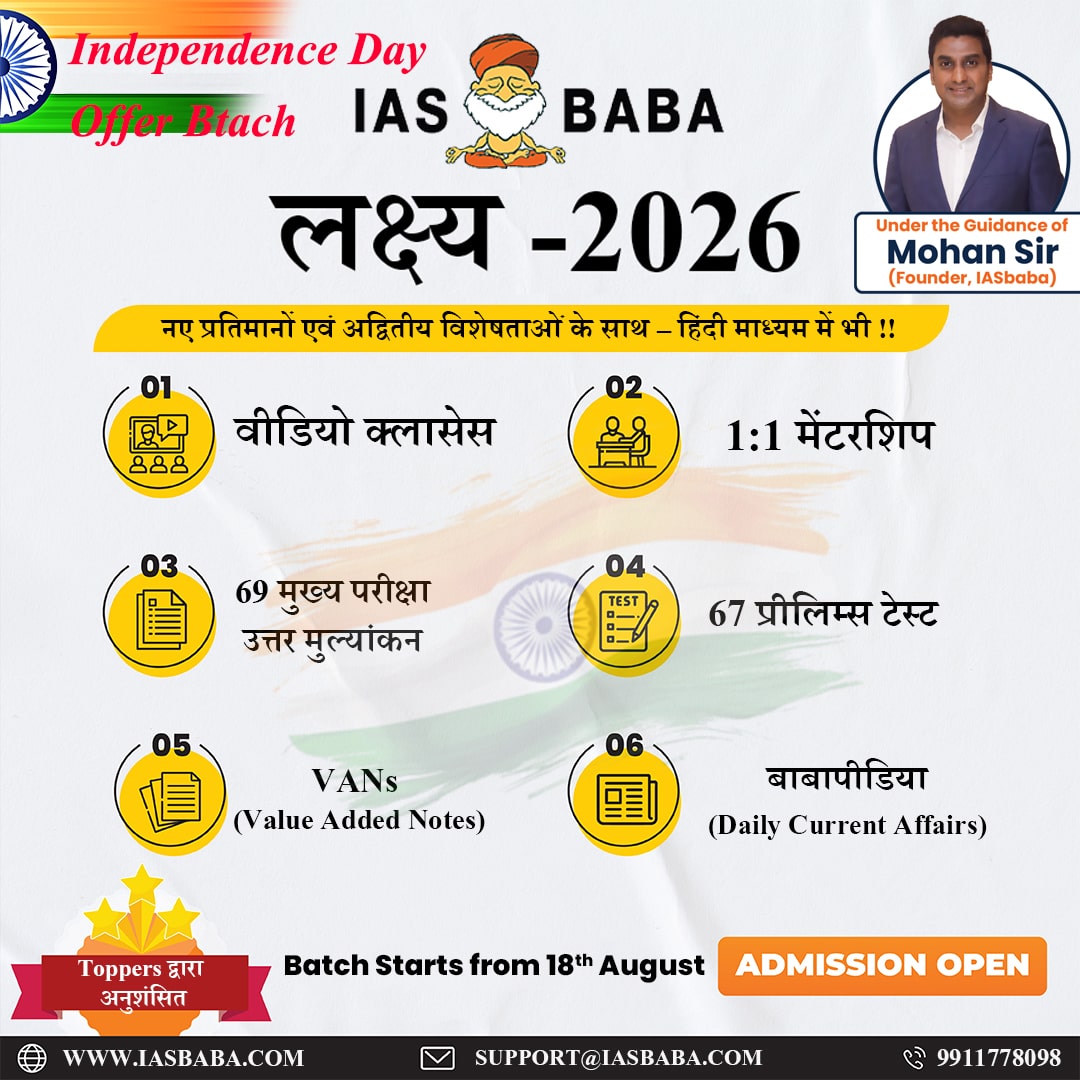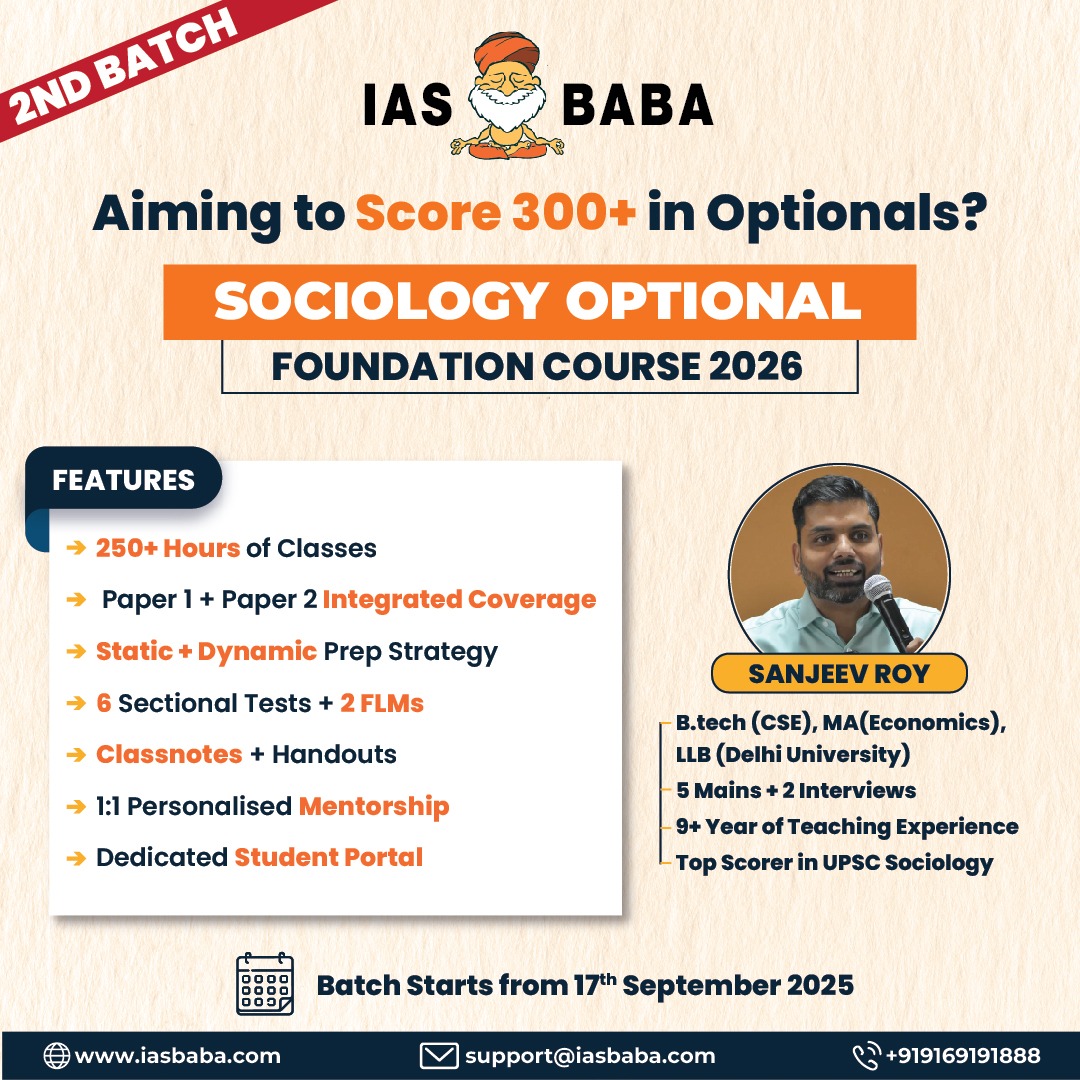IASbaba's Daily Current Affairs Analysis
Archives
(PRELIMS Focus)
Category: INTERNATIONAL
Context: India’s population has touched 1.4639 billion (146.39 crore) in 2025, officially making it the most populous country in the world
Decoding Context:
According to the UNFPA State of World Population Report 2025, this figure marks a major demographic milestone with long-term implications.
Key Highlights:
- Population (2025): 1.4639 billion
- Fertility Rate: 1.9 births per woman (below replacement level of 2.1)
- Life Expectancy: 71 years (men), 74 years (women)
- Age Distribution:
- 0–14 years: 24%
- 10–19 years: 17%
- 10–24 years: 26%
- 15–64 years (working age): 68%
- 65+ years: 7%
- Population Peak: Expected around 1.7 billion in the early 2060s, after which it will gradually decline.
- Demographic Dividend: With 68% in the working-age group, India has a key economic opportunity if employment and skilling are addressed effectively.
Fertility & Reproductive Trends:
- Fertility rate has dropped from nearly 6 children per woman in the 1960s to 1.9 in 2025.
- Decline driven by improved education, access to healthcare, and women’s empowerment.
- However, 36% of adults still experience unintended pregnancies, and 30% report unmet reproductive desires, indicating inequality in access and reproductive autonomy across regions.
Policy Focus:
- The report urges a shift from population control to reproductive rights.
- The true demographic dividend can only be realized by empowering individuals with informed reproductive choices, and ensuring access to quality healthcare, education, and job opportunities.
Conclusion:
India stands at a pivotal moment in its demographic journey. While falling fertility rates and better life expectancy are positive signs, realizing the benefits of this transition depends on inclusive policies, reproductive agency, and economic empowerment of the working-age population.
Learning Corner:
Decadal Census in India – Brief Note
Definition:
The Census of India is a decennial (once every 10 years) exercise conducted to collect comprehensive demographic, socio-economic, and housing data of the country’s population. It is the largest administrative and statistical exercise in the world.
Historical Background:
- The first synchronous census was conducted in 1881 under British rule.
- Since then, it has been carried out every 10 years without fail, even during wars, pandemics, or emergencies.
- The Registrar General and Census Commissioner of India, under the Ministry of Home Affairs, is responsible for conducting the census.
Key Features:
- Conducted in two phases:
- House-listing & Housing Census
- Population Enumeration
- Involves lakhs of enumerators, mainly government school teachers and other staff.
- Census 2011 was the 15th National Census since 1881.
Census 2021 (Postponed):
- Census 2021 was to be the 16th decadal census.
- It has been postponed indefinitely due to the COVID-19 pandemic and administrative reasons.
- This is the first time since 1881 that a decadal census has been delayed.
Importance of the Census:
- Provides data for planning, policy-making, and allocation of resources.
- Essential for delimitation of constituencies, reservation of seats, and distribution of funds to states.
- Helps track migration trends, literacy levels, employment, housing conditions, and access to basic amenities.
Challenges:
- Digital transition: Census 2021 was to be the first digital census, using mobile apps for data collection.
- Political sensitivity over caste-based enumeration (demand for caste census).
- Urban-rural coverage, underreporting, and data accuracy remain persistent concerns.
Conclusion:
The decadal census remains a cornerstone of India’s governance and development planning. With growing demands for more granular socio-economic data (e.g., caste census), its scope and complexity are increasing, making its timely and transparent execution more critical than ever.
Source : THE HINDU
Category: SCIENCE AND TECHNOLOGY
Context The Karlsruhe Tritium Neutrino (KATRIN) experiment in Germany has set a new world record for the smallest upper limit on the mass of the electron neutrino
Decoding Context:
How It Works:
- KATRIN measures the energy of electrons emitted during the beta decay of tritium.
- By analyzing the endpoint of the energy spectrum, it infers the neutrino mass.
- The setup includes a 70-meter-long beamline and a 200-tonne spectrometer.
Key Highlights:
- New Limit: Neutrino mass < 0.45 eV/c² (at 90% confidence).
- Data Used: 250 days of data, 36 million electron events.
- Comparison: Most precise direct and model-independent measurement so far.
- Cosmology vs. Lab: While cosmological models suggest even smaller combined masses, KATRIN’s direct approach avoids theoretical dependencies.
Significance & Future Prospects:
- Neutrinos are key to understanding physics beyond the Standard Model, cosmic evolution, and structure formation.
- KATRIN continues to collect data and aims to push sensitivity to 0.3 eV by the end of 2025.
- The findings may open doors to new physics.
Learning Corner:
What are Neutrinos?
Neutrinos are fundamental subatomic particles that belong to the family of leptons in the Standard Model of particle physics. They are:
- Electrically neutral
- Have extremely small mass (but not zero)
- Interact very weakly with matter (only via weak nuclear force and gravity)
- Can pass through ordinary matter almost undisturbed
Types of Neutrinos:
There are three known flavors of neutrinos, each associated with a charged lepton:
- Electron neutrino (νₑ)
- Muon neutrino (ν_μ)
- Tau neutrino (ν_τ)
Key Properties:
| Property | Value / Note |
|---|---|
| Charge | 0 (neutral) |
| Spin | ½ (fermion) |
| Interaction | Weak nuclear force, gravity only |
| Mass | Extremely small, non-zero (~<1 eV) |
| Speed | Close to speed of light |
Neutrino Sources:
- Natural Sources: Sun (solar neutrinos), cosmic rays, supernovae, Earth’s interior (geoneutrinos)
- Man-made: Nuclear reactors, particle accelerators, and beta decay experiments
Important Phenomena:
- Neutrino Oscillation: Neutrinos can change from one flavor to another, which implies they have mass — a discovery that led to the 2002 Nobel Prize in Physics.
- Mass Measurement: Experiments like KATRIN aim to determine their absolute mass directly.
Why Are Neutrinos Important?
- They are essential to understanding the Standard Model and physics beyond it.
- Help explain matter-antimatter asymmetry in the universe.
- Offer insights into cosmic evolution, nuclear reactions, and dark matter candidates.
- Due to their weak interaction, they are excellent probes of processes deep inside stars and supernovae.
Neutrino Comparison Table
| Property | Neutrino | Electron | Photon |
|---|---|---|---|
| Type | Lepton | Lepton | Boson (Force carrier) |
| Electric Charge | 0 | −1 | 0 |
| Mass | Very small, non-zero | ~9.11 × 10⁻³¹ kg | 0 |
| Interaction | Weak force, gravity | EM, weak, gravity | Electromagnetic only |
| Spin | ½ (Fermion) | ½ (Fermion) | 1 (Boson) |
| Speed | Close to light speed | Much slower | Speed of light |
| Penetrating Power | Extremely high | Low | Moderate to high |
Source: THE HINDU
Category: ECONOMICS
Context : The U.S. dollar has fallen nearly 10% in 2025, making it one of the weakest performers among major U.S. asset classes
Decoding Context:
The decline is driven primarily by a global surge in hedging activity among foreign investors, reflecting growing uncertainty in U.S. policy and market behaviour.
Key Reasons for Dollar Weakness
- Rising Hedging by Global Investors: Investors are now hedging U.S. equity positions more aggressively—unlike in the past, where equities were seen as a natural hedge. This widespread increase in hedge ratios is reducing demand for the dollar.
- Fading U.S. Exceptionalism: Confidence in the U.S. economic narrative has waned amid shifting policies and global trade tensions, especially under the current administration.
- Broken Correlations: Typically, the dollar rises when U.S. stocks fall. However, in 2025, both have been falling together. This unusual behaviour has weakened the dollar’s status as a portfolio hedge.
- Hedging Trends from Global Funds: Large foreign pension funds have sharply increased their currency hedges on U.S. assets—some by over 10% in just months—leading to massive currency flows out of the dollar.
- Trade Tensions and Outflows: Persistent geopolitical frictions, especially U.S.-China tensions, have added to foreign investor caution, accelerating capital outflows from U.S. markets.
Learning Corner:
Currency Appreciation and Depreciation: Concepts and Impact on Trade
Definitions
- Currency Appreciation
- When the value of a country’s currency rises relative to another currency (usually the US Dollar), it is called appreciation.
- → Example: ₹75/USD → ₹70/USD (1 USD now costs fewer rupees).
- Currency Depreciation
- When the value of a country’s currency falls relative to another currency, it is called depreciation.
- → Example: ₹75/USD → ₹80/USD (1 USD now costs more rupees).
Impact on Trade
| Impact | Appreciation of Currency | Depreciation of Currency |
|---|---|---|
| Exports | Becomes costlier in global markets → ↓ | Becomes cheaper → more competitive → ↑ |
| Imports | Becomes cheaper → import bill ↓ | Becomes expensive → import bill ↑ |
| Trade Balance | May worsen (exports ↓, imports ↑) | May improve (exports ↑, imports ↓) |
| Current Account Deficit | Likely to increase | May reduce |
| Foreign Investment Appeal | Attracts more capital (safe haven effect) | May reduce unless higher returns offered |
| Inflation | Lower (cheaper imports, e.g., oil) | Higher (costlier imports) |
Link to US Dollar (USD) Appreciation or Depreciation
Since the US dollar is the dominant global reserve and trade currency, any movement in USD impacts almost every major economy, including India.
If the US Dollar Appreciates (e.g., due to Fed rate hikes, risk aversion):
- Indian Rupee tends to depreciate → Makes oil, electronics, and other imports expensive.
- India’s exports become more competitive, boosting textile, IT, and pharma sectors.
- Worsens CAD if imports (especially crude oil) rise in value.
- FII outflows occur as investors shift to USD-denominated assets → weaker rupee.
If the US Dollar Depreciates (e.g., due to US economic slowdown, Fed rate cuts):
- INR tends to appreciate → Imports become cheaper, easing inflation.
- Exports may lose price competitiveness in global markets.
- Encourages capital inflows into emerging markets like India.
Source : THE HINDU
Category: SCIENCE AND TECHNOLOGY
Context : The Digital India Bhashini Division (DIBD) and Centre for Railway Information Systems (CRIS) have signed an MoU to develop next-generation multilingual AI solutions for Indian Railways’ digital platforms
Decoding Context
Key Objectives:
- Language AI Integration: Technologies like Automatic Speech Recognition (ASR), Text-to-Text Translation, Text-to-Speech (TTS), and Optical Character Recognition (OCR) will be integrated into platforms like NTES and RailMadad.
- Support for 22 Indian Languages: Enhances access to services in native languages across mobile apps, websites, kiosks, and call centers.
- AI-Driven Passenger Services: Introduction of multilingual chatbots, voice assistants, and real-time voice interaction systems.
- Scalable Infrastructure: Uses both cloud and on-premise models to ensure reliable deployment across the vast railway network.
- Pilot Programs: Includes workshops and trial deployments to fine-tune the system before full-scale implementation.
Strategic Importance:
This collaboration supports the Digital India mission by removing language barriers in public services and enhancing digital inclusivity. It is expected to benefit millions of railway passengers, especially non-English speakers.
This initiative marks a major leap in citizen-centric digital transformation for Indian Railways.
Learning Corner:
Brief Note on BHASHINI
BHASHINI (BHASHa INterface for India) is a flagship initiative under the Digital India programme, launched by the Ministry of Electronics and Information Technology (MeitY), Government of India. Its core mission is to enable access to digital services in all 22 scheduled Indian languages, breaking the language barrier in technology adoption across the country.
Key Features:
- National Language Translation Mission (NLTM): BHASHINI is the implementing arm of NLTM, aiming to create a unified digital public platform for multilingual language technologies.
- Technology Stack: It provides open-source tools for:
- Automatic Speech Recognition (ASR)
- Machine Translation
- Text-to-Speech (TTS)
- Optical Character Recognition (OCR)
- Open Ecosystem: Encourages collaboration between startups, academia, industry, and government to develop language AI tools and datasets.
- Public Platform: Hosts a Bhashadaan portal to crowdsource language data, fostering AI model development for low-resource Indian languages.
Significance:
-
- Promotes digital inclusion by ensuring non-English speakers can access government schemes, health services, education, and e-commerce in their own language.
- Supports Make in India and Atmanirbhar Bharat by building indigenous AI capabilities.
- Facilitates the creation of voice-enabled and language-neutral digital platforms for public services.
- Recent Applications:
- MoUs with CRIS (Railways), NPCI (UPI voice transactions), and other departments to integrate multilingual AI into public services.
- Empowering platforms like UMANG, MyGov, and DigiLocker with language support.
Source: PIB
Category: ECONOMICS
Context : Prime Minister Narendra Modi shared an article on the progress made in Technical textiles
Decoding Context:
India’s technical textiles sector is witnessing rapid growth, driven by two major government initiatives: the National Technical Textiles Mission (NTTM) and the Production Linked Incentive (PLI) scheme. Together, these programs aim to transform India into a global leader in this high-value, innovation-driven segment.
Key Outcomes (as of 2025)
| Indicator | Value |
|---|---|
| Domestic Market Growth (Annual) | 10% |
| Exports (Technical Textiles) | $2.9 billion |
| Total Investment Attracted | ₹5,218 crore |
| Employment Generated | 8,500+ jobs |
| Sector Turnover | ₹3,242 crore |
| Export Revenue (TT alone) | ₹217 crore |
Conclusion
NTTM and PLI have redefined India’s approach to technical textiles—from an import-dependent industry to one that is self-reliant, innovative, and globally competitive. The sector is now crucial to India’s strategic interests in defence, infrastructure, health, and sustainability.
Learning Corner:
- National Technical Textiles Mission (NTTM)
- Launch & Vision: Introduced in 2020 with a budget of ₹1,480 crore to make India a global leader by 2026.
- Key Focus Areas: Research, innovation, market development, exports, and skill development.
- Achievements:
- 168 research projects supported.
- Training for over 50,000 individuals.
- Mandated use of 73 technical textile items in public projects.
- Strategic Sectors Covered: Aerospace, defence, agriculture, healthcare, infrastructure, and environment.
- Ecosystem Building:
- 17 startups incubated.
- Over 2,000 students trained.
- 16 industry-linked skilling modules developed.
- Global Presence: Participation in 30+ international events; man-made textile exports rose from $4.2B (2020–21) to $5.3B (2024–25).
- Production Linked Incentive (PLI) Scheme
- High-Value Manufacturing: Focuses on critical products like carbon fiber, glass fiber, and automotive safety textiles.
- Objective: Boost large-scale domestic production and reduce dependence on imports.
- Global Competitiveness: Aims to challenge key exporters like China and Vietnam in the technical textiles space.
Source : THE ECONOMIC TIMES
(MAINS Focus)
Introduction (Context)
- The Kerala government has sought the Centre’s approval to amend the Wildlife (Protection) Act, 1972, to allow the state to cull wild animals that pose threats to human life and agricultural livelihoods.
- However, this issue is not confined to Kerala alone. Across India, human-animal conflicts are rising, with growing instances of crop damage, loss of life, and displacement caused by wildlife entering human habitats.
Human Animal Conflict
- Human-wildlife conflict refers to the negative interactions between humans and wild animals, often resulting in harm to both parties.
- The issue in Kerala:
-
- Wildlife attacks have emerged as a major issue in Kerala, with the government identifying 273 village local bodies, out of 941, as hotspots.
- The problem animals are mainly tiger, leopard, elephant, bison, wild boar, bonnet macaque and peafowl. Although bonnet macaque (a monkey species) and peafowl do not pose a threat to life, their repeated raids have forced farmers to abandon vast tracts of agricultural land.
- Crop damage, livestock predation, and damage to infrastructure can lead to significant economic losses for farmers and communities.
- According to the government data, as many as 919 persons were killed and 8,967 others injured in wildlife attacks in Kerala from 2016-17 to 2024-25 (till January 31).
Reason for the rise in cases
- Habitat degradation forcing wildlife into human settlements.
- Overgrazing by domestic cattle in forests.
- Changing cropping patterns and increased cultivation near forest areas.
- Population explosion of wild boars and monkeys, especially bonnet macaques.
Challenges in Present laws
- The existing legal framework puts several constraints in taking timely action in emergency situations, , especially in the case of animals protected under Schedule I of the Act.
- Schedule I of the Wildlife Protection Act, 1972 provides the highest level of protection to critically endangered species, prohibiting hunting, poaching, killing, and trading. This schedule covers species like the tiger, blackbuck, and various other animals and birds, with severe penalties for violating the law.
- Hence for killing the animal during human animal conflict following procedure is followed:
-
- Before ordering the killing of dangerous wild animals, the state chief wildlife warden should be convinced that it cannot be captured, tranquilised or shifted to another place.
- Such captured animals should not be held under confinement.
- The government has to follow the advisory of the Tiger Conservation Authority and Project Elephant Scheme while dealing with human-wildlife conflict.
- While the district collector, who is the executive magistrate, can issue orders for removal of a public nuisance, there are court orders preventing the invoking of these powers with regard to wild animals.
Demands of Kerala government
- Amend Wildlife (Protection) Act, 1972 to:
-
- Allow culling of man-eating and crop-destroying animals under regulated conditions.
- Provide for seasonal and region-specific permissions for culling.
- Ease procedural barriers to taking action during emergencies.
- Declare wild boars as “vermin” under Section 62 of the Act — enabling easier culling.
- Remove bonnet macaques from Schedule I, restoring earlier provisions where the chief wildlife warden could take suo motu action.
Value Addition
1. Vermin Species
- Section 62 of the Wildlife (Protection) Act, 1972 empowers the Central Government to declare certain wild animals as vermin in specific areas and for a specified period.
- Vermin are usually considered problem or nuisance animals that attack humans, crops, livestock or property.
- Species which are classified as Vermin are placed under Schedule V of the Wildlife Protection Act, of 1972.
- Once declared vermin, these animals can be hunted or culled without penalty.
- Helps control overpopulated or crop-destroying species (e.g., wild boars, nilgai) and reduces human-wildlife conflict while still preserving protection in core habitats.
2. Wildlife (Protection) Act, 1972
- It is the principal legislation for the protection of wild animals, birds, and plants in India.
- Provides for the creation of protected areas (national parks, wildlife sanctuaries).
- Animals are listed under Schedules I to VI:
- Schedule I & II: Highest protection.
- Schedule V: Vermin category.
- The Wildlife Protection Act, 1972, established several key bodies to aid in wildlife conservation and protection. These include the National Board for Wildlife (NBWL), State Boards for Wildlife (SBWL), the Central Zoo Authority (CZA), the National Tiger Conservation Authority (NTCA), and the Wildlife Crime Control Bureau (WCCB).
3. National Tiger Conservation Authority (NTCA)
- Constituted under the Wildlife (Protection) Act, 1972 (amended 2006).
- A statutory body under the Ministry of Environment, Forest and Climate Change (MoEFCC).
- Mandated to:
- Implement Project Tiger.
- Ensure scientific monitoring, protection, and management of tiger reserves.
- Approve plans for mitigation of tiger-human conflict.
- Provide technical and financial support to states.
4. Project Elephant
- Launched in 1992 by MoEFCC to:
- Protect Asian elephants, their habitat, and corridors.
- Address man-elephant conflict through mitigation strategies and community participation.
- Support captive elephant welfare and eco-development.
- Includes financial and technical support to states for elephant protection and corridor management.
Way forward
- Implement a dynamic conflict-mapping system to identify and monitor emerging wildlife hotspots in real-time.
- Ensure fast-track administrative and judicial approvals for emergency wildlife control actions.
- Explore non-lethal methods like sterilisation, translocation, and immunocontraception where feasible.
- Use technology-driven monitoring tools (drones, camera traps, GPS tagging) for population and movement tracking.
- Invest in restoring degraded forests and creating ecological buffer zones between wildlife habitats and agricultural fields.
- Promote the cultivation of non-palatable crops in high-conflict zones to deter herbivorous wildlife.
- Involve local communities, forest dwellers, and farmers in conflict mitigation planning through training and incentives.
- Strengthen eco-development committees (EDCs) and joint forest management (JFM) platforms.
- Ensure timely and adequate compensation for loss of life, livestock, and crops due to wildlife attacks.
- Promote crop and livestock insurance schemes specifically designed for wildlife-prone regions.
- Launch awareness campaigns to sensitise people on coexistence, conflict reporting, and risk mitigation practices.
Conclusion
Kerala’s push for legal flexibility in managing human-wildlife conflict underscores the need to harmonise conservation goals with ground realities. A rational and humane approach must guide reforms in the Wildlife (Protection) Act to ensure both ecological integrity and human security.
Mains Practice Question
Q The increasing frequency of human-wildlife conflict in India poses serious governance and legal challenges. Critically examine the limitations of the Wildlife (Protection) Act, 1972, in managing such conflicts. Should states be given more flexibility in responding to localized threats? (250 words, 15 marks)
Introduction (Context)
The United Nations General Assembly has declared 2026 as the International Year of the Woman Farmer, supported by over 100 countries. This move recognizes the vital yet underappreciated role of women in agriculture and seeks to raise awareness about the challenges they face.
Role of Women in Agriculture
- Women play a significant and crucial role in agricultural development and allied fields.
- With growing rural to urban migration by men, there is ‘feminisation’ of agriculture sector, with increasing number of women in multiple roles as cultivators, entrepreneurs, and labourers.
- Mainly rural women are engaged in agricultural activities in three different ways depending on the socio-economic status of their family and regional factors. They work as:
-
- Paid Labourers.
- Cultivator doing labour on their own land.
- Managers of certain aspects of agricultural production by way of labour supervision and the participation in post harvest operations.
- The types of agricultural activities taken up by women include the following : Sowing, Nursery management, Transplanting, Weeding, Irrigation, Fertilizer application, Plant protection, Harvesting, winnowing, storing etc.
Data:
- As per Census 2011, out of total female main workers, 55 per cent were agricultural labourers and 24 per cent were cultivators. However, only 12.8 per cent of the operational holdings were owned by women, which reflect the gender disparity in ownership of landholdings in agriculture. Moreover, there is concentration of operational holdings (25.7 per cent) by women in the marginal and small holdings categories.
- The workforce participation rate for rural females is higher at 30.5 percent against urban women participation rate of 20.20 percent (MoSPI, 2022-23).
- As per the Annual Periodic Labour Force Survey (PLFS) Report 2022-23, agriculture had the highest estimated percentage distribution of female workers, i.e. 64.3 %, with 76.2 % in rural areas and 11.7 % in urban areas.
- In India, 80% of economically active women are employed in agriculture.
- Only 14% of agricultural landowners in India are women. As per NFHS-5, female land ownership is only 8.3%.
Issues faced by Women in agriculture
1. Land Ownership and Financial Access
- Limited land ownership prevents women from accessing credit, insurance, and government subsidies.
- Microfinance and SHGs offer small-scale support, but are insufficient for larger investments.
2. Access to Information and Technology
- Women have limited access to mobile phones and agricultural advisories.
- This leads to low adoption of technology and poor resilience-building.
3. Impact of Climate Change
- Women face greater climate vulnerability due to added domestic responsibilities and fewer resources.
- Their exposure to agriculture-related climate risks is disproportionately higher.
4. Lack of Infrastructure
- A large number of women farmers operate at the subsistence and smallholder level, and a disproportionate share of the agricultural production is left in their hands.
- With little or no access to modern improved technologies, there is a huge problem to secure them reasonable investments in capital, inputs and labor.
Government Initiatives
1. Mahila Kisan Sashaktikaran Pariyojana (MKSP): Aims to upgrade skills, enhance resource access, and promote sustainable agriculture among women farmers.
2. Sub-Mission on Agricultural Mechanisation: Provides 50%–80% subsidies for machinery purchase by women farmers.
3. National Food Security Mission: Allocates 30% of its budget to women farmers in various States/UTs.
4. National Mission on Natural Farming (NMNF): Promotes sustainable farming practices through women-led Self Help Groups (SHGs) like Krishi Sakhis and Pashu Sakhis. Empowers women by involving them in the entire agricultural value chain—from pre-production to post-production.
5. Agricultural Technology Management Agency (ATMA) Scheme: Targets the gender gap in agricultural extension services. Promotes Farm Women’s Food Security Groups (FSGs) – 2 per block annually with ₹10,000 support per group. Reserves 30% of scheme beneficiaries and resources for women farmers.
6. Central Sector Scheme of Agri-Clinics and Agri-Business Centres (AC&ABC) of the Ministry of Agriculture and Farmers’ Welfare: Women entrepreneurs are eligible for a 44% subsidy, compared to 36% for others.
Case Study: Project ENACT, Assam
Implemented in Nagaon district, Assam, ENACT empowers women farmers through access to climate-resilient solutions and localized advisories.
Key Features:
- Weekly mobile advisories sent to 300+ women farmers in 17 villages.
- Climate Adaptation Information Centres support video conferencing and agri-awareness.
- Promotion of flood-resistant rice varieties and nutrition-sensitive crops.
- Collaboration with agricultural universities and government departments for climate-resilient seeds and knowledge.
Value addition
Women’s empowerment in agriculture index
- The Women’s Empowerment in Agriculture Index (WEAI) measures the empowerment, agency, and inclusion of women in the agriculture sector in an effort to identify ways to overcome those obstacles and constraints.
- The Index is a significant innovation in its field and aims to increase understanding of the connections between women’s empowerment, food security, and agricultural growth.
- It measures the roles and extent of women’s engagement in the agriculture sector in five domains:
-
- decisions about agricultural production,
- access to and decision making power over productive resources,
- control over use of income,
- leadership in the community, and
- time use.
- It also measures women’s empowerment relative to men within their households.
- It is published by International Food Policy Research Institute (IFPRI) in collaboration with USAID and Oxford Poverty and Human Development Initiative (OPHI).
Gender Parity Index (GPI):
- WEAI includes a Gender Parity Index that measures the relative empowerment of women compared to men in the same household.
- Helps assess whether women have equal decision-making power.
Way Forward
1. Gender-Sensitive Policy Design
- Policies must incorporate gender-disaggregated data to reflect women’s realities.
- Farming tools, extension services, credit products must be designed for women.
2. Strengthening Agri-Value Chains
- Women-managed value chains should be supported and scaled.
- Collective action and SHGs can be strengthened to enhance market access.
3. Promoting Resilience and Sustainability
- Invest in climate-smart practices, livelihood diversification, and nutrition-focused farming.
- Promote community seed systems and localized advisory networks.
Conclusion
The declaration of 2026 as the International Year of the Woman Farmer offers a historic opportunity to recognize and support women in agriculture. Strengthening their role can ensure food security, climate resilience, and gender equality, making agriculture truly inclusive and sustainable.
Mains Practice Question
Q “Land ownership and access to institutional support remain the biggest barriers to empowering women in Indian agriculture.” Examine the challenges faced by women farmers and evaluate the effectiveness of government initiatives in addressing them.(250 words, 15 marks)
Daily Practice MCQs
Today’s – Daily Practice MCQs’ will be updated in our “Daily Current Affairs Quiz” section on our website
Please click on the below link













